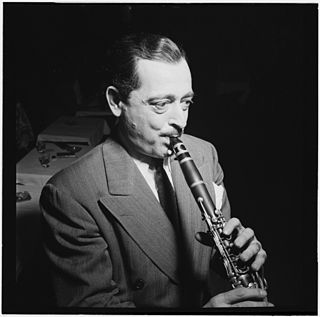
The Original Dixieland Jass Band (ODJB) was a Dixieland jazz band that made the first jazz recordings in early 1917. Their "Livery Stable Blues" became the first jazz record ever issued. The group composed and recorded many jazz standards, the most famous being "Tiger Rag". In late 1917, the spelling of the band's name was changed to Original Dixieland Jazz Band.
George Vital "Papa Jack" Laine was an American musician and a pioneering band leader in New Orleans in the years from the Spanish–American War to World War I. He was often credited for training many musicians who would later become successful in jazz music.

Edward "Kid" Ory was an American jazz composer, trombonist and bandleader. One of the early users of the glissando technique, he helped establish it as a central element of New Orleans jazz.

Dominic James "Nick" LaRocca, was an American early jazz cornetist and trumpeter and the leader of the Original Dixieland Jass Band, who is credited by some as being "the father of modern jazz". He is the composer of one of the most recorded jazz classics of all-time, "Tiger Rag". He was part of what is generally regarded as the first recorded jazz band, a band which recorded and released the first jazz recording, "Livery Stable Blues" in 1917.

Gustave "Gussie" Mueller was an early jazz clarinetist.

Emile Joseph Christian, sometimes spelled Emil Christian, was an American early jazz trombonist; he also played cornet and string bass. He also wrote a number of tunes, including "Meet Me at the Green Goose", "Satanic Blues", and "Mardi Gras Parade".

Lawrence James Shields was an early American dixieland jazz clarinetist. He was a member of the Original Dixieland Jazz Band, the first jazz band to record commercially.

Alcide Patrick Nunez, also known as Yellow Nunez and Al Nunez, was an American jazz clarinetist. He was one of the first musicians of New Orleans to make audio recordings.

Edwin Branford Edwards was an early jazz trombonist who was a member of the Original Dixieland Jass Band.

Frank Joseph Christian was an American early jazz trumpeter.

Charles Ellsworth "Pee Wee" Russell was an American jazz musician. Early in his career he played clarinet and saxophones, but he eventually focused solely on clarinet.

"Big Eye" Louis Nelson Delisle was an American early twentieth-century Dixieland jazz clarinetist in New Orleans, Louisiana, United States. He also played double bass, banjo, and accordion.

"Tiger Rag" is a jazz standard that was recorded and copyrighted by the Original Dixieland Jass Band in 1917. It is one of the most recorded jazz compositions. In 2003, the 1918 recording of "Tiger Rag" was entered into the U.S. Library of Congress National Recording Registry.

The origin of the word jazz is one of the most sought-after etymologies in modern American English. Interest in the word – named the Word of the Twentieth Century by the American Dialect Society – has resulted in considerable research and the linguistic history is well documented. "Jazz" originated in slang around 1912 on the West Coast. The meaning varied, but the word did not initially refer to music. "Jazz" came to mean jazz music in Chicago around 1915.

The Louisiana Five was an early Dixieland jazz band that was active from 1917 to 1920. It was among the earliest jazz groups to record extensively. The Louisiana Five was led by drummer Anton Lada.

Tony Parenti was an American jazz clarinetist and saxophonist born in New Orleans, Louisiana, United States. After starting his musical career in New Orleans, he had a successful career in music in New York City for decades.

"Livery Stable Blues" is a jazz composition copyrighted by Ray Lopez and Alcide Nunez in 1917. It was recorded by the Original Dixieland Jass Band on February 26, 1917, and, with the A side "Dixieland Jass Band One-Step" or "Dixie Jass Band One-Step", became widely acknowledged as the first jazz recording commercially released. It was recorded by the Victor Talking Machine Company in New York City at its studio at 46 West 38th Street on the 12th floor – the top floor.

Bert Kelly was an American musician, who pioneered jazz as a banjoist, bandleader, educator, promoter, night club owner, and night club operator. After professional stints in Seattle and San Francisco, Kelly moved to Chicago in 1914 where he flourished a banjoist, bandleader, and promoter. In 1915 — before the U.S. prohibition — he founded and operated a Chicago speakeasy called "Bert Kelly's Stables," where patrons were introduced to early jazz.
Dixieland jazz, also referred to as traditional jazz, hot jazz, or simply Dixieland, is a style of jazz based on the music that developed in New Orleans at the start of the 20th century. The 1917 recordings by the Original Dixieland Jass Band fostered awareness of this new style of music.

Reisenweber's Cafe, also known as Reisenweber's Restaurant or simply Reisenweber's, was a restaurant, nightclub, and hotel in Columbus Circle, Manhattan, on the intersection of Eighth Ave and 58th Street, from 1856/7 to 1922.

















